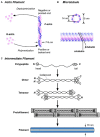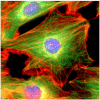Onco-Esthetics Dilemma: Is There a Role for Electrocosmetic-Medical Devices?
- PMID: 33585180
- PMCID: PMC7879986
- DOI: 10.3389/fonc.2020.528624
Onco-Esthetics Dilemma: Is There a Role for Electrocosmetic-Medical Devices?
Abstract
Objective: The primary aim of this review is to verify whether the warning against the use of electromedical instruments in the cosmetic professional or medical cancer patient settings is consistent with evident oncological risks supported by experimental in vitro/in vivo studies or anecdotal clinical reports, or any other reasonable statement.
Methods: MEDLINE, PubMed, Embase, AMED, Ovid, Cochrane Controlled Trials Register, and Google Scholar databases were electronically searched. Data relating to research design, sample population, type of electro-cosmetic devices used, were extracted.
Results: The search strategy identified 50 studies, 30 of which were potentially relevant.
Conclusions: Our research is in favor of moderate periodical use of cosmetic medical devices in patients bearing tumors, in any stage, like in healthy people. Special consideration is dedicated to massage, manipulation, and pressure delivery upon the cytoskeleton of cancer cells that has proven to be sensitive to mechanical stress at least in some specific locally relapsing cancers such as osteosarcoma.
Keywords: cancer; cosmetic; electro-cosmetic device; esthetician; esthetics; medical devices; onco-esthetic; oncology esthetics.
Copyright © 2021 Palmieri, Palmieri, Mambrini, Pepe and Vadalà.
Conflict of interest statement
The authors declare that the research was conducted in the absence of any commercial or financial relationships that could be construed as a potential conflict of interest.
Figures











Comment in
-
Commentary: Onco-Esthetics Dilemma: Is There a Role for Electrocosmetic-Medical Devices?Front Oncol. 2021 Sep 30;11:718277. doi: 10.3389/fonc.2021.718277. eCollection 2021. Front Oncol. 2021. PMID: 34660283 Free PMC article. No abstract available.
References
-
- Institute of Medicine (US) Committee on Assessing Interactions Among Social, Behavioral, and Genetic Factors in Health, Hernandez LM, Blazer DG. Genes, Behavior, and the Social Environment: Moving Beyond the Nature/Nurture Debate. Washington, DC: National Academies Press. (2006). 10.1128/cmr.14.4.810-820.2001 - DOI - PubMed
Publication types
LinkOut - more resources
Full Text Sources
Other Literature Sources

